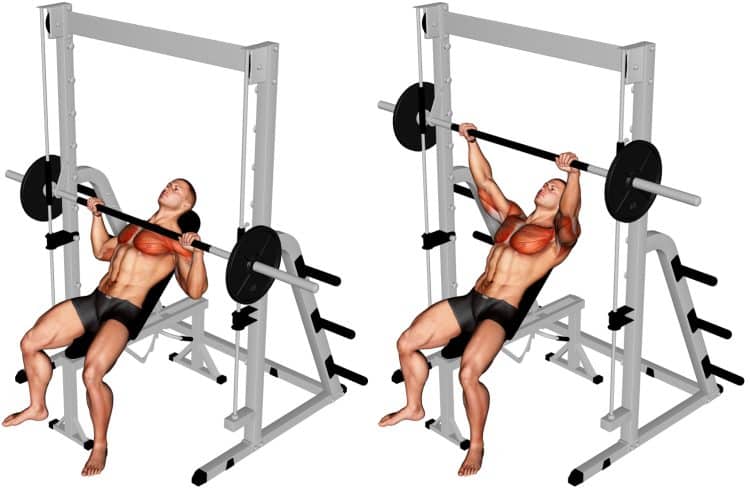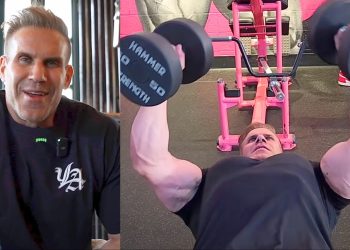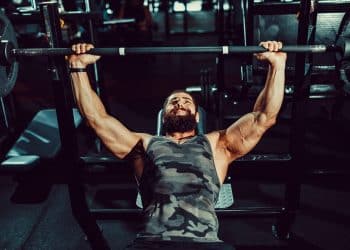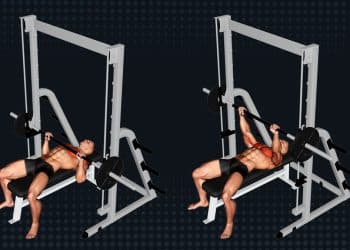While it’s true you cannot target a specific part of a single muscle (e.g., lower or upper abs), science and real world results say you can emphasize certain muscle fiber sections by utilizing various body angles and positions. According to a 2020 study, performing the bench press on a 30-degree incline produces greater upper chest activation (1).
The Smith machine incline press is one of the best variations in our opinion for hitting the upper pecs and we think it’s better than the freeweight version in many ways.
Check out our full detailed guide below for exercise tips and tricks and more.
How To Do Smith Machine Incline Bench Presses
In this section, we’ve included detailed instructions for setting up the bench, proper body positioning and targeting the chest muscles safely and effectively. Smith machines should be used with extra caution as they do require a little more preparation time and attention to detail.
Step 1: Setting up for the press
Before you start, make sure that your bench is positioned evenly in the center of the machine between both rails. Then you want to lie on the bench with an empty bar and slide yourself forward or backward to find the ideal bar path in relation to your torso. We recommend unracking the unloaded bar and doing a few reps to find your setup. The bar should come down to your upper chest just below the clavicle bone.
You then want to determine the right starting bar height for your arm length. This will allow you to un-rack the bar efficiently and without having to exert too much effort. Like the freeweight bench press, you want to be able to un-rack the bar and start with the arms fully extended.
Level Up Your Fitness: Join our 💪 strong community in Fitness Volt Newsletter. Get daily inspiration, expert-backed workouts, nutrition tips, the latest in strength sports, and the support you need to reach your goals. Subscribe for free!
The next very important step especially if you’re lifting heavy loads without human assistance is to set the spotter arms in place. They should be low enough to give you a full range of motion but high enough to give you a little space to get out from under the bar in the event that you need to bail the weight.
Step 2: Hand width and grip
Now that you have the bench and bar in place, it’s time to set yourself up for a perfect press. Keep in mind, there are different body types and arm lengths.
Pro tip: To find your hand placement on the bar, press your upper arms into your sides then move them out at a 70-75 degree angle to your torso. Now reach up and grab the bar. Do a few practice reps and adjust slightly if needed but not that much.
We recommend using a full grip with the thumbs wrapped around the bar, however, more advanced exercisers may prefer to use a thumbless grip.
Step 3: Placing your feet
Your feet play an important role in bench press performance because they help to give you a solid base, stability, and additional pushing power. While bench pressing foot position can sometimes vary depending on one’s preference and comfort, most people will get the best results by planting their feet flat on the ground under the knees.
If your feet are too far forward, you cannot possibly get enough leverage to push. Likewise if they’re too back, you’ll be pressing on your toes and give up a lot of power assistant.
Step 4: Shoulder retraction and lat engagement
If you want to get the most out of your bench press efforts, it is imperative that you have a checklist to ensure you’re setting up in a way that will maximize your pushing performance. After the bench and bar are in place, you’re ready to fire up the muscles that will assist in the press.
To do this:
- Retract your shoulders into the bench, stick your chest up and flare your lats out. This will create a natural arch in your lower back and press the upper back down into the bench, giving you a solid base that acts as a counterforce as you press the bar in the opposite direction. You need to have completed all of the above steps before you un-rack the bar and begin the bench press.
Step 5: Lower and Press!
Now you’re in position and ready for the press.
To do it:
- Rotate your wrists to un-rack the bar and push it up toward the ceiling until your elbows are fully extended.
- Now lower the bar down until it touches your upper chest right below the clavicle bone or stop a few inches short if you have shoulder issues and inhale during this portion of the rep.
- Then contract your chest muscles and use your triceps to press the bar back up to full arm extension while exhaling.
- Repeat for the desired number of repetitions and then try to re-rack the bar on the same spot that you un-racked it.
Pro tip: If you have limited shoulder mobility, try to lower the bar to within at least three inches from your chest for decent pec activation.
Watch this very short video instructional on the Smith incline press.
We also included another more in-depth video demonstration that has some very valuable training tips for the Smith incline press.
Read also: How To Do The Smith Bench Press
5 Smith Machine Incline Bench Press Benefits
Why would you choose the Smith bench press as a substitute for the freeweight variation? Here are three reasons.
No need to balance and stabilize
A heavy advantage of the smith or any machine exercise is that you don’t have to worry about balancing a barbell or stabilizing your core to keep it in place (you still need to stabilize the spine during machine presses though).
For those who hate the idea of having to stabilize heavy weight, this is the variation for you. Should you completely replace the freeweight version? Not at all as both have their pros and cons.
Related: 8 Ways to Boost Your Bench Press
May be better for pure strength gains
Some people may not agree but the balance and stabilization requirements with freeweight movements typically means you won’t be able to lift as much. When it comes to machine exercises, you’re able to get under the weight and focus strictly on moving it.
That leads us to another benefit…
No spotter required
Smith machines typically win in the safety category when it comes to not crushing your chest with a heavy barbell unless you’re using spotter arms in a power rack or something similar. You can use safety hooks on a Smith so that the bar will stop just above your chest and this is a huge deciding factor for many exercisers.
Good option for beginners
A 44-pound barbell can be too heavy for a lot of beginners to start with, hence why we like the Smith bench press in this instance. We’re not saying it has all the benefits of a freeweight press but it is performed from a lying position and using a long bar. So at least you’ll be in the same position and from there you can learn correct pressing technique and body mechanics.
May be better on the shoulders compared to freeweight barbell press
Smith machines do tend to offer exercisers a more pain free option for the shoulders. Possibly because the bar is not moving around which can stress the shoulders joints especially if you don’t have great shoulders in the first place.
Drawbacks
What are the less desirable traits of Smith bench presses?
Not as accessible compared to a freeweight barbell and rack
One major drawback of Smith presses is that, well, you need a Smith machine. If you train at a gym then it’s no issue but most people who train at home will have a freeweight setup because it’s typically much more affordable.
Does not allow for natural movement patterns
While Smith bench presses are one of our favorite chest exercises, they can be restricting depending on which type you have access to. You may need to spend a little time moving the bench and doing several practice reps to find a position that allows you to comfortably execute the exercise while also feeling it in the muscles and not the shoulders.
Level Up Your Fitness: Join our 💪 strong community in Fitness Volt Newsletter. Get daily inspiration, expert-backed workouts, nutrition tips, the latest in strength sports, and the support you need to reach your goals. Subscribe for free!
Requires a little more setup time
While it shouldn’t be a dealbreaker, Smith machines typically don’t come with benches attached. Which means you’ll need to set the bench up under the bar evenly on both sides and perfectly aligned with where you want to the bar to be in relation to your chest.
Common Mistakes
If you can avoid making these key mistakes, the Smith bench press can give you the gains you’re looking for.
Too much incline
Incline presses can be a fantastic way to stimulate the upper chest muscles, however, there is a point of diminishing returns. The study on bench press angle mentioned in the intro to this article found that setting a bench on an incline higher than a 45-degree angle may be counterproductive, shifting significantly more of the load onto the front delts and less on the pectoralis major (largest chest muscles) (1).
If you want to feel the difference try switching between lower and higher angles.
Forcing the movement
Despite what some would have you believe, it’s not a crime to stop a few inches short of touching your chest. Incline barbell exercises can place additional stress on the shoulders and going too far down can feel awkward and painful, and the last thing you want to do is force it to go lower when there’s not much benefit there.
The most important thing is that you feel a decent stretch in the chest and no shoulder pain or discomfort.
Pro tip: Dumbbells can be the better choice in this instance.
Too much elbow flare
A common barbell incline press mistake is flaring the elbows out too much. This usually occurs when you lower the bar too high up on the chest by the clavicle bone. You can flare the elbows but too wide and you’re asking for a shoulder injury. That means you’ll need to bring the bar a little lower on the chest. As long as you’re on an incline bench you’re still working the upper chest.
Variations and Alternatives
Variety and options makes training exciting and effective but we’d go as far as to say that using different angles and equipment is important for maxing out your progress. Check out these Smith bench press variations and alternatives that we prefer.
1. Dumbbell incline press
Arguably a better exercise altogether for many people, dumbbells are a unilateral training tool that allow us to work each side separate of each other. The advantages are freer movement of the limbs, enhanced training coordination and identifying left to right imbalances, a luxury you don’t get with barbell training.
2. Alternative chest press machine
While Smith presses are the closest machine replication of a freeweight barbell press, please do take advantage of the other chest press machine offerings at your gym. While there are no replacements for barbell and dumbbell chest presses, we’d rather you find what feels good to you. While your form will ultimately dictate the feel of a movement, certain variations just feel better.
3. Freeweight bench press
All those funny chest day memes are based on one exercise and that is none other than the barbell bench press. It is the standard by which upper body strength is measured and nothing can take its place. Does that mean it’s the best chest exercise? Well, there are a lot of factors that you’d have to consider before making that claim.
However, a study conducted by the American Council on Exercise (ACE) found that the freeweight barbell bench press resulted in 100% chest muscle activation using electromyographic (emg) technology.
It was concluded that for this study, the bench press was found to be the superior pec builder when compared to eight other variations including the pec deck, cable crossovers, chest press machine, inclined dumbbell fly, dips, and push-ups (suspended, stability ball, and standard), respectively (2).
The study was based on a flat press however, we would think the incline variation would elicit similar results.
Utilize these 15 Best Barbell Bench Press Variations for a stronger press.
4. Decline push-ups!
When it comes to bodyweight chest exercises the push-up and its variations are king. Many people will get to a point where the basic push-up is no longer as effective but the beauty of this phenomenal movement is there are so many ways to make them more challenging so that you can keep getting bigger and stronger. You can do them declined, inclined, single-arm, handstand, weighted and the options are endless.
The declined variation elevates the lower body and re-angles the arms so that more of the weight shifts toward the upper chest area. Keep in mind though, the higher the decline beyond a beyond a 30-degree angle may work more of the anterior delts.
Read: 12 Reasons To Do Push-Ups Every Day
5. Bonus: Guillotine press
While it wouldn’t be our first choice, the guillotine press is always an option when you don’t have access to an incline bench. It’s not an exercise you want to go heavy on without using a spotter otherwise it can be as scary as what the name implies. You can do a flat or incline version of this movement.
Try these 10 Effective Incline Bench Press Alternatives
How Much Does A Smith Machine Bar Weigh?
While it’s not exactly relevant as long as the bar supports your workouts, most, if not all gym bros and gals have at some point wondered how much a Smith bar weighs compared to the common 20 kilograms or 44 pounds freeweight bench press barbell.
Smith machines typically weight anywhere between 7-30 pounds depending on the variation. Learn more about Smith Machine bar weights here.
Program Smith Machine Incline Presses in Workouts
If your upper chest is lacking in size and fullness, we recommend placing it at the forefront of your upcoming training sessions. That way you can spend fresh energy to blast those upper pecs fibers and force growth into your chest.
If you want to walk into the gym and hit a new push day pr but also want to give the upper pecs attention, then go all out on the flat bench press and then do more volume with less weight on the incline bench press.
Ideally, you’ll mix in a combination of both training methods to maximize your chest development.
We also recommend incorporating Smith incline presses when you’re less energized, feeling off, or even when you’re recovering or coming back from an injury (not medical training advice). Sometimes freeweights are not the answer although they are important.
Sets and Reps
Smith presses are an awesome multi-use chest exercise due to the simple fact you’re locked into a fixed bar path. Therefore, you can focus on completing your reps without having to battle against stabilizing a free moving barbell.
- Strength: 2-4 sets x 4-6 reps
- Hypertrophy: 2-4 sets x 8-12 reps
- Muscle hypertrophy and endurance: 3 sets x 15+ reps
Muscles Worked
- Pectoralis Major Sternal Head – The chest has a lower sections of fibers that draws the arms downward and in toward the center of the body.
- Pectoralis major clavicular head – The upper clavicular head is a section of chest fibers closest to the shoulders that helps with flexion, horizontal adduction, as well as inward rotation of the upper arm.
- Triceps brachii – Triceps are the muscles on the back of the upper arm that sometimes resemble a horseshoe when flexed. It has three heads – lateral, medial, and posterior that function to extend the arm, and support the body’s weight during certain exercises.
- Deltoids anterior – Anterior deltoids are of three muscles in the shoulder located on the front of torso that raise the arm up and forward, and assists during other shoulder functions.
- Core muscles – Abs, obliques and spinal erector muscles are considered part of your core. The abdominals crunch your upper and lower torsos together, and stabilize your spine. Obliques twist your trunk and the erectors allow us to stand up straight.
Bottom Line
If you felt like something was missing from your chest training, the Smith machine incline press may be it. This upper chest focused variation can be the perfect alternative to freeweight incline presses as many find it to be a more shoulder-friendly option. You don’t have to balance a bar and because the Smith locks you in, you can focus on pure chest contraction and improving your pressing technique.
Interested in measuring your progress? Check out our strength standards for Bench Press, Push Ups, Dumbbell Fly, and more.









